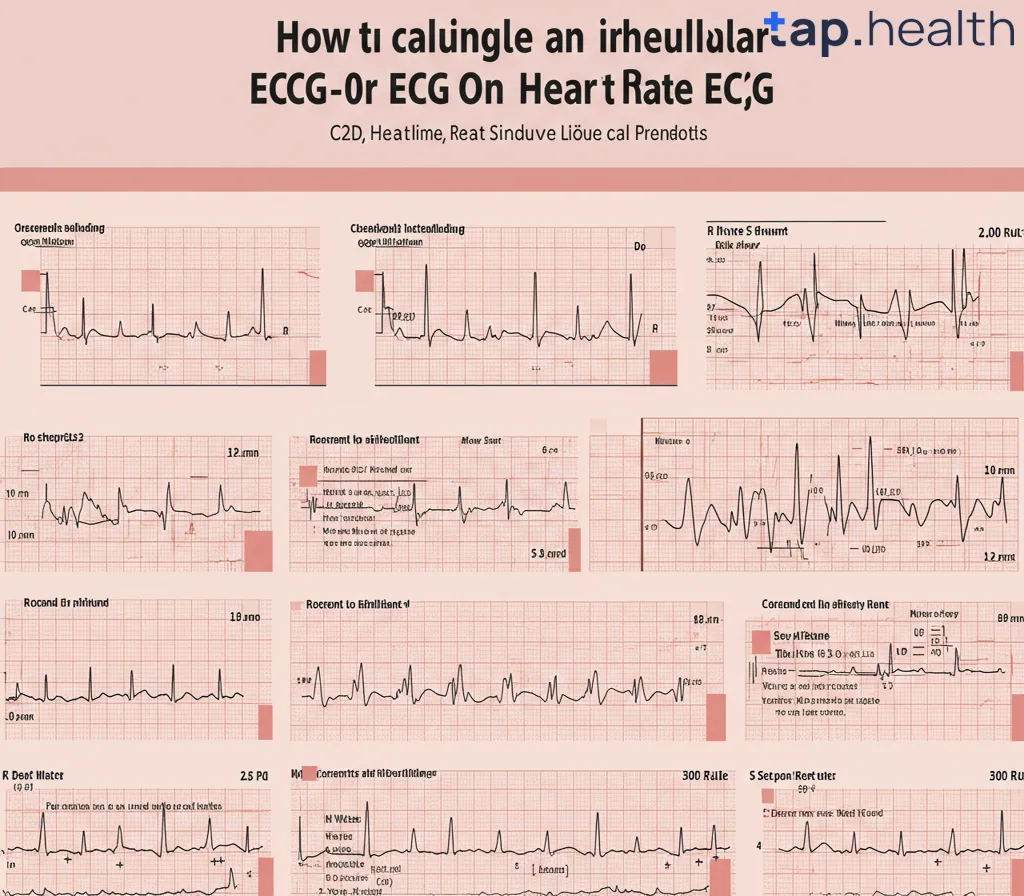An ECG (Electrocardiogram) is one of the most common tests used by doctors to measure the electrical activity of your heart. It’s a valuable diagnostic tool that helps doctors assess your heart’s rhythm, detect heart conditions, and even evaluate the irregularities in your heart rate. But how do you calculate an irregular heart rate on an ECG? If you’re new to ECGs, the process may seem a little complex at first. However, in this comprehensive guide, we’ll break it down into simple steps.
In this article, we’ll explore how to calculate an irregular heart rate, how to interpret the rhythms on the ECG, and the different types of irregular heartbeats that may appear. We’ll also cover the causes and significance of these irregularities, and why understanding them is crucial for heart health.
What is an ECG?
An ECG, or Electrocardiogram, is a test that measures the electrical activity of the heart. It produces a graphical representation (tracing) that shows the timing of the electrical signals as they travel through the heart. This test helps doctors evaluate the heart rate, rhythm, and overall health of the heart.
Key Components of an ECG
An ECG recording consists of several key components that make up the heart’s electrical cycle:
- P Wave: Represents atrial depolarization (contraction of the heart’s upper chambers).
- QRS Complex: Represents ventricular depolarization (contraction of the heart’s lower chambers).
- T Wave: Represents ventricular repolarization (relaxation of the ventricles after contraction).
By analyzing the pattern, timing, and intervals between these waves, medical professionals can diagnose various heart conditions, including arrhythmias (irregular heartbeats).
What is an Irregular Heart Rate?
An irregular heart rate refers to a condition where the heart beats at an abnormal or inconsistent pace. The rhythm may be too fast (tachycardia), too slow (bradycardia), or have an unpredictable pattern. Arrhythmias can lead to serious health issues such as stroke, heart failure, or cardiac arrest.
When you look at an ECG, an irregular heart rate often appears as abnormal intervals between the heartbeats or uneven spacing between the P waves, QRS complexes, and T waves.
Types of Irregular Heart Rhythms
- Atrial Fibrillation (AFib): Rapid, irregular heartbeats originating in the atria (upper chambers of the heart).
- Premature Ventricular Contractions (PVCs): Early heartbeats that originate in the ventricles (lower chambers).
- Ventricular Tachycardia (VT): A rapid heart rate originating in the ventricles.
- Bradycardia: A slow heart rate, typically fewer than 60 beats per minute.
How to Calculate Irregular Heart Rate on ECG
Calculating an irregular heart rate on an ECG can seem daunting at first, but with the right steps, it becomes a manageable task. Here’s a step-by-step guide to help you calculate the irregular heart rate from an ECG:
Step 1: Understand the Basics of ECG Timing
Before you calculate the irregular heart rate, it’s important to understand the timing intervals on the ECG paper. ECG paper is typically marked with small and large squares that represent time intervals:
- Small squares represent 0.04 seconds.
- Large squares represent 0.20 seconds.
Step 2: Identify the R-R Interval
The R-R interval is the time between two consecutive R waves (the sharp upward deflection in the QRS complex) and is used to calculate heart rate. For irregular heart rhythms, the time between R waves will vary.
How to Find the R-R Interval:
- Locate the R waves: Identify the peaks of the QRS complexes on the ECG.
- Measure the distance between two consecutive R waves using the small and large squares on the ECG paper.
- Record the interval: Measure the time from one R wave to the next. This is your R-R interval.
Step 3: Calculate the Heart Rate
Now that you have the R-R interval, you can calculate the heart rate. There are different methods for calculating the heart rate depending on whether the rhythm is regular or irregular.
For Regular Rhythms:
- Count the number of R-R intervals in one minute. If the rhythm is regular, you can simply count the number of large squares between two R waves and divide 300 by that number. For example, if the R-R interval spans 3 large squares, the heart rate is 100 beats per minute (300 ÷ 3 = 100 bpm).
For Irregular Rhythms:
For irregular rhythms, calculating the heart rate becomes slightly more complex. In these cases, you can use the mean method or calculate the average heart rate over a specific period:
- Measure several R-R intervals: Choose at least 5 R-R intervals from different parts of the ECG to get a representative sample.
- Calculate the average R-R interval: Add up the measured intervals and divide by the number of intervals to get an average R-R interval.
- Convert the interval to heart rate: Use the formula Heart Rate = 60 / Average R-R Interval (where the average R-R interval is in seconds). This will give you the average heart rate.
Step 4: Assess the Heart Rhythm
Once you’ve calculated the heart rate, examine the rhythm for any irregularities:
- Are the intervals between R waves consistently different?
- Is the heart rate too fast (tachycardia) or too slow (bradycardia)?
Step 5: Interpret the Results
After calculating the irregular heart rate, it’s important to interpret the results. Irregular heart rhythms could be a sign of a medical condition such as atrial fibrillation or ventricular arrhythmias. Depending on the result, further medical evaluation may be necessary to determine the cause and appropriate treatment.
Why is it Important to Calculate Irregular Heart Rate?
Monitoring and calculating an irregular heart rate is crucial for several reasons:
1. Detecting Heart Conditions
Irregular heart rates can be indicative of underlying conditions such as arrhythmias, heart disease, or electrolyte imbalances. Detecting these early can help prevent complications like stroke, heart failure, or cardiac arrest.
2. Monitoring Treatment Effectiveness
For individuals with known heart conditions or arrhythmias, tracking heart rate over time can help doctors determine if the prescribed treatment (e.g., medication or lifestyle changes) is working effectively.
3. Assessing Overall Heart Health
An irregular heart rate could be a sign of stress, lack of exercise, or poor cardiovascular health. Regular monitoring can help identify risk factors early, prompting preventive care and lifestyle adjustments.
Common Causes of Irregular Heart Rate
An irregular heart rate doesn’t always indicate a serious health problem, but it could signal various underlying causes. Here are some common factors that can lead to irregular heart rhythms:
1. Electrolyte Imbalances
Imbalances in potassium, calcium, or magnesium can disrupt the electrical signals in the heart, causing arrhythmias.
2. Heart Disease
Conditions like coronary artery disease, heart failure, or heart valve problems can affect the heart’s rhythm.
3. High Blood Pressure
Chronic hypertension can increase the workload on the heart, leading to arrhythmias.
4. Stress and Anxiety
Mental stress can increase the production of hormones like adrenaline, which can trigger irregular heartbeats.
5. Stimulants and Medications
Drugs such as caffeine, nicotine, and certain medications can increase the risk of arrhythmias.
How Can You Improve Your Heart Rhythm?
If you have an irregular heart rate, there are several lifestyle changes and treatments that can help:
1. Healthy Diet
Eating a heart-healthy diet rich in fruits, vegetables, and whole grains while avoiding excessive salt and fat can help manage heart rate.
2. Regular Exercise
Engaging in regular physical activity can improve heart health and reduce the likelihood of arrhythmias.
3. Stress Management
Practicing relaxation techniques like meditation, deep breathing, and yoga can help reduce stress and prevent irregular heart rhythms.
4. Medications and Treatments
In some cases, medications like beta-blockers or anti-arrhythmic drugs may be prescribed to help manage irregular heartbeats. In severe cases, treatments like cardioversion or pacemaker implantation might be necessary.
FAQ on How to Calculate Irregular Heart Rate on ECG
1. What is an Irregular Heart Rate?
An irregular heart rate, or arrhythmia, refers to an abnormal or uneven rhythm of the heartbeats. This can be caused by various factors such as heart disease, electrolyte imbalances, or stress.
2. How Do I Calculate Irregular Heart Rate on an ECG?
To calculate the irregular heart rate on an ECG, measure the distance between the R waves (R-R interval), and then calculate the average R-R interval. Use the formula Heart Rate = 60 / Average R-R Interval to find the heart rate.
3. What Causes Irregular Heart Rates?
Irregular heart rates can be caused by conditions like heart disease, electrolyte imbalances, stress, high blood pressure, or the use of certain medications or stimulants.
4. Can I Diagnose Irregular Heart Rate on an ECG?
While an ECG can help identify irregular heart rhythms, diagnosing the underlying cause requires a thorough medical evaluation by a healthcare professional.
5. What Is Atrial Fibrillation?
Atrial fibrillation (AFib) is a common type of irregular heartbeat that originates in the atria (upper chambers of the heart). It is characterized by rapid, erratic electrical signals and is a significant risk factor for stroke.
Conclusion
Calculating an irregular heart rate on an ECG is a useful skill for anyone working with heart health data. By following the steps outlined in this guide, you can measure and understand heart rhythm irregularities effectively. Irregular heart rates, while often benign, may indicate serious conditions that require medical attention. If you notice any signs of an irregular heart rate, such as palpitations, shortness of breath, or dizziness, be sure to seek medical advice promptly. Understanding how to calculate and interpret irregular heart rhythms is key to early diagnosis and intervention, helping to maintain optimal heart health.



